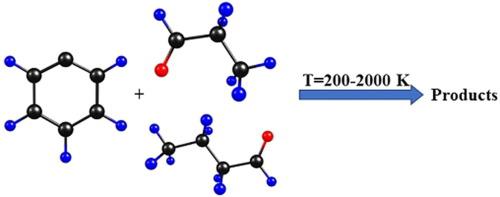Chemical Physics Letters ( IF 2.8 ) Pub Date : 2020-08-27 , DOI: 10.1016/j.cplett.2020.137915 Parth Gupta , B. Rajakumar

|
The reactivity of phenyl radical towards propionaldehyde and butyraldehyde was investigated by the CVT/SCT/ISPE method using the energetics computed at the CCSD(T)//B3LYP/cc-pVTZ level of theory over the temperature range of 200–2000 K. The rate coefficients (k × 1014 cm3 molecule−1 sec−1) for two aldehydes were computed to be 7.7 and 15.2 at 298 K. The branching ratios explained the contribution of H-abstraction reaction channels to the global reactivity. The degradative mechanism explained the formation of acids, aldehydes, and peroxy nitrates. The reactivity of these aldehydes towards phenyl radicals was also compared with their reactivity towards other atmospheric oxidants.
中文翻译:

在200–2000 K的温度范围内,苯基自由基与丙醛和丁醛的反应
通过CVT / SCT / ISPE方法,使用在200–2000 K的温度范围内以CCSD(T)// B3LYP / cc-pVTZ理论水平计算的能量,研究了自由基对丙醛和丁醛的反应性。计算出两个醛在298 K时的速率系数(k×10 14 cm 3分子-1 sec -1)为7.7和15.2。支化比解释了H吸收反应通道对整体反应性的贡献。降解机理解释了酸,醛和过氧硝酸盐的形成。还将这些醛对苯基的反应性与它们对其他大气氧化剂的反应性进行了比较。


















































 京公网安备 11010802027423号
京公网安备 11010802027423号